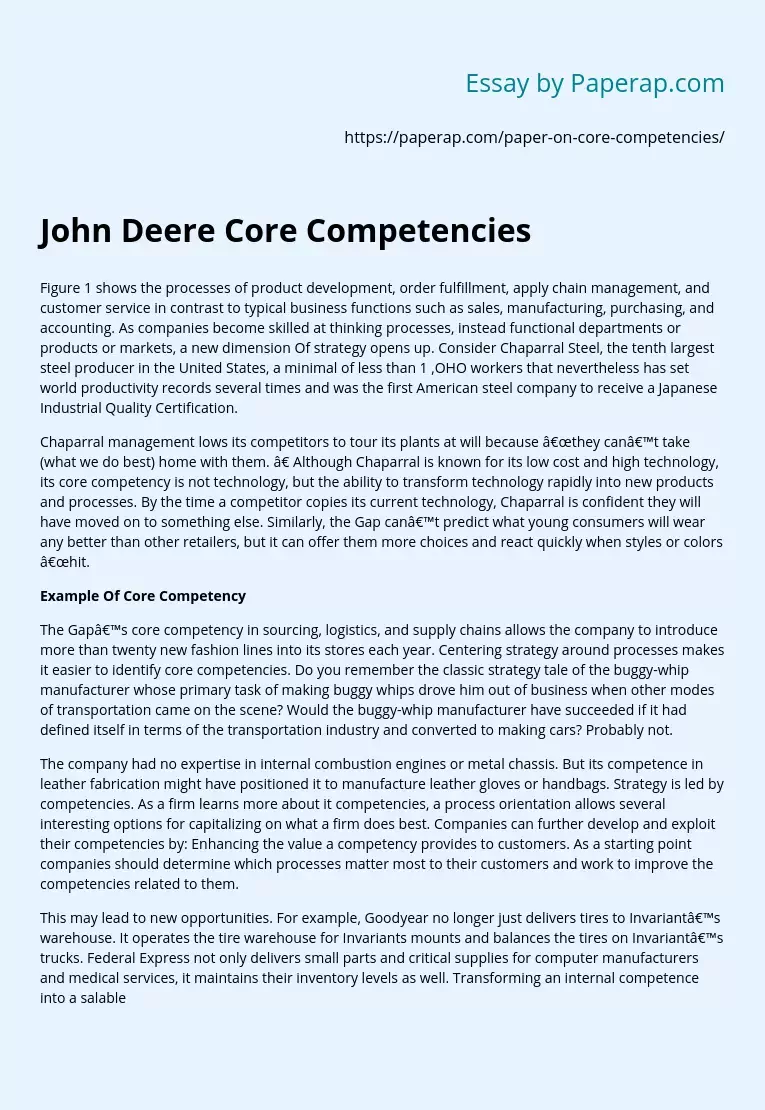John Deere Core Competencies
Figure 1 shows the processes of product development, order fulfillment, apply chain management, and customer service in contrast to typical business functions such as sales, manufacturing, purchasing, and accounting. As companies become skilled at thinking processes, instead functional departments or products or markets, a new dimension Of strategy opens up. Consider Chaparral Steel, the tenth largest steel producer in the United States, a minimal of less than 1 ,OHO workers that nevertheless has set world productivity records several times and was the first American steel company to receive a Japanese Industrial Quality Certification.
Chaparral management lows its competitors to tour its plants at will because “they can’t take (what we do best) home with them. ” Although Chaparral is known for its low cost and high technology, its core competency is not technology, but the ability to transform technology rapidly into new products and processes. By the time a competitor copies its current technology, Chaparral is confident they will have moved on to something else.
Similarly, the Gap can’t predict what young consumers will wear any better than other retailers, but it can offer them more choices and react quickly when styles or colors “hit.
Example Of Core Competency
The Gap’s core competency in sourcing, logistics, and supply chains allows the company to introduce more than twenty new fashion lines into its stores each year. Centering strategy around processes makes it easier to identify core competencies. Do you remember the classic strategy tale of the buggy-whip manufacturer whose primary task of making buggy whips drove him out of business when other modes of transportation came on the scene? Would the buggy-whip manufacturer have succeeded if it had defined itself in terms of the transportation industry and converted to making cars? Probably not.
The company had no expertise in internal combustion engines or metal chassis. But its competence in leather fabrication might have positioned it to manufacture leather gloves or handbags. Strategy is led by competencies. As a firm learns more about it competencies, a process orientation allows several interesting options for capitalizing on what a firm does best. Companies can further develop and exploit their competencies by: Enhancing the value a competency provides to customers. As a starting point companies should determine which processes matter most to their customers and work to improve the competencies related to them.
This may lead to new opportunities. For example, Goodyear no longer just delivers tires to Invariant’s warehouse. It operates the tire warehouse for Invariants mounts and balances the tires on Invariant’s trucks. Federal Express not only delivers small parts and critical supplies for computer manufacturers and medical services, it maintains their inventory levels as well. Transforming an internal competence into a salable item. American Airlines markets its SABER reservation system to airlines and travel agents, and its maintenance system o other airlines. Triton of Massachusetts sells its telemarketing services: L.
L Bean markets its customer service process; and Xerox, Westinghouse, AT & T, and others have spun off firms to market their quality-improvement processes. Applying competencies in a creative way to new products and services. H&R Block used its expertise in recruiting and managing short term employees during tax season to create a competitive advantage in the field of temporary services. Creating new competencies and finding new markets. John Deere, a farm equipment manufacturer, developed impenitence in financial services so that it could provide its retail dealer network with insurance.
The company later sold these processes to automobile dealers, boat dealers, and recreational dealers. Rare and valuable resources and capabilities are the fundamental source of competitive advantage. Resources are tangible (e. G. , equipment, machinery, mail list), intangible (e. G. , brand name, customer knowledge, money), or human assets that the firm currently possesses. Resources likely emerge as the result of prior investments, actions or ongoing capabilities. I’ve provided you with examples of John (Deer’s Company) marketing resources below. Knowledge and Informational Resources Customer information system (i. . , a CRM database) Customer knowledge or understanding Reseller (e. G. , retailer) knowledge or understanding Relational Resources Customer loyalty Customer relationships Reseller (e. G. , brokers, retailer) relationships Legal Resources Brand Trademarks Reputation Resources Brand equity Brand awareness Physical Resources Distribution network Retail locations Human Resources Company-owned sales force Organizational & F-uncial Resources All forms of capital (money, plant, equipment) might be relevant, especially if the lack of these resources creates a constraint.
And capabilities are compel patterns of skills in deploying resources (e. G. , patents, know-how, brand names, equipment) to perform a task or activity to produce a desired end result. Deere is particularly interested in dynamic capabilities that the company can apply to “create, extend, or modify its resource base. ” I’ve provided you with examples of John (Deer’s Company) marketing capabilities below. Product Management Ability to develop and deliver superior-q laity and/or customized goods and revise.
Communications Management and Brand-building capability Ability to create and manage customer value perceptions leading to high levels of brand equity, using effective: positioning, advertising message delivery, personalized communications, and integrated marketing communications. Pricing Management Ability to extract the optimal revenue and profit from customers through price discrimination tactics, for example, using a sophisticated yield management system capability. This is unrelated to the ability to charge a high price (which is a function of product or marketing differentiation) or a owe price (which is a function of cost leadership).
Channel Management Ability to establish and manage channels of distribution that effectively and efficiently deliver value to end-user customers. Customer Relationship Management Ability to identify profitable customers and prospects and initiate, maintain, and leverage relationships with these customers to create superior customs level profits. Requires data collection & interpretation capability for individual customers, individual customer targeting capability, and personalized communications capability.
John Deere Core Competencies. (2019, Dec 05). Retrieved from https://paperap.com/paper-on-core-competencies/

